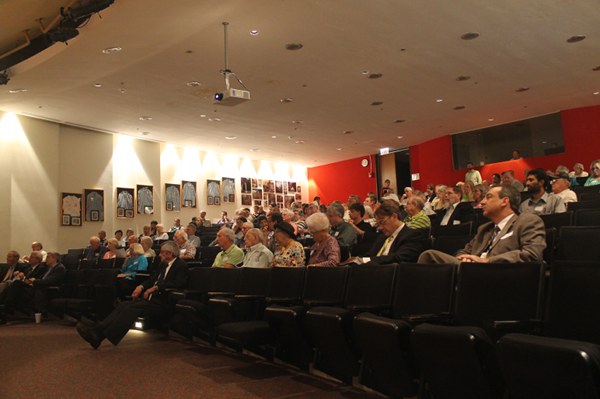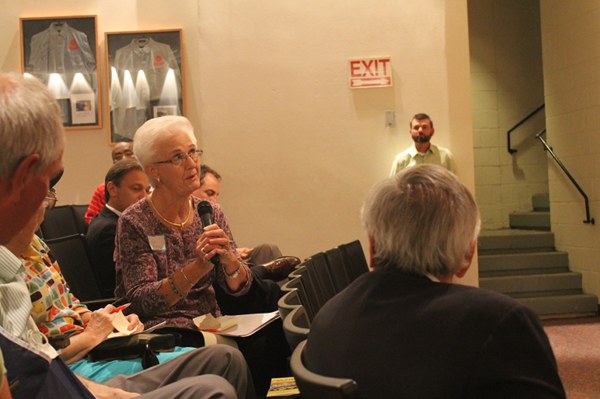
During Thursday’s community meeting at AMSE, David Moore, left, said a few words about his background after being introduced by Oak Ridge City Manager Mark Watson, right. (Photos by Sara Wise)
The American Museum of Science and Energy Foundation teamed up with the City of Oak Ridge on Thursday to host the first of four community meetings meant to allow the community to have some input into the future of the museum, and how it might fit into the proposed Manhattan Project National Historical Park.
The first meeting was at the museum on Thursday night. It began with presentations that focused on providing information to help audience members make informed suggestions about the museum.
Oak Ridge National Laboratory Communication Director David Keim was among those who made presentations. He said that the museum attracted 71,500 visitors in 2013 and received $1.6 million in federal funding.
Keim explained why AMSE’s contract with Enterprise Advisory Services Inc. was allowed to run out June 30.
“We didn’t think it made sense to continue paying money to a company that went to Texas,” he said.
Additionally, Keim spoke about the five museum professionals who provided consultation. He said they called the museum “internationally significant, but tired.”

The auditorium at the American Science and Energy Museum in Oak Ridge was nearly full during Thursday evening’s community meeting to discuss AMSE’s future.
On Friday, photographer and columnist Ray Smith, who is recognized for his knowledge of local history, said the museum professionals agreed that the city has a great story to tell, but the museum’s exhibits need to be updated.
Others who gave presentations on Thursday included Oak Ridge City Manager Mark Watson, AMSE Foundation President Wayne Stevenson, and Gerald Boyd, former manager of the U.S. Department of Energy’s Oak Ridge Office. Oak Ridge Mayor Tom Beehan also opened and closed the meeting with a few words.
Most of the meeting was made up of a question-and-answer style conversation led by Watson. He gave the audience some questions to help guide the discussion, but many people spoke more candidly about their ideas.
When asked what the ideal museum would look like, many in the audience mentioned the necessity for interactive exhibits. One person spoke of “more hands-on activities for children,” and others said to “make (the museum) a place where people want to go.”
After the event, Watson said he was very pleased with the turnout, which nearly filled AMSE’s auditorium.
“I think that there’s an endless array of ideas, but for the end result, we need to…figure out those baby steps, and then giant steps, to move ahead,” he said.
Watson has said the museum’s future is dependent on how to mitigate federal budgetary constraints and shifting concepts of science museums.

Audience members offered suggestions to AMSE Director David Moore during Thursday’s community meeting.
Moore, who became AMSE director on July 1, said he and other museum staff took notes throughout the event and he is looking forward to going through all the suggestions that were discussed, as well as written suggestions handed in at the end of the meeting.
“We can work wonders if we work together,” he said.
The next three meetings are tentatively scheduled for August 19, September 25, and October 14, from 6 p.m. to 8 p.m. U.S. Senator Lamar Alexander has been invited to speak at the August meeting, while the third is slated to include talks from Tennessee Tourism Commissioner Susan Whitaker. The fourth and final meeting invites a “roundtable with regional museum directors.”
The museum opened in 1949, and is is owned by the U.S. Department of Energy. It showcases the history of the Manhattan Project and the current scientific, energy, and national security missions carried out by DOE facilities in Oak Ridge.
Oak Ridge National Laboratory currently manages the museum for DOE and contributes, along with other major DOE contractors in Oak Ridge, to the operating costs. The museum’s funding comes from a three-way split between ORNL, the Y-12 National Security Complex, and the former K-25 site, now known as East Tennessee Technology Park.
Officials have long said that DOE should not be operating the museum because the department is not in the museum business.
The Manhattan Project National Historical Park proposal being considered in Congress would include Oak Ridge; Los Alamos, N.M.; and Hanford, Wash. All three sites played key roles in the Manhattan Project, a top-secret effort to build the world’s first atomic weapons during World War II.
Sara Wise is a freelance contributor to Oak Ridge Today.
Leave a Reply